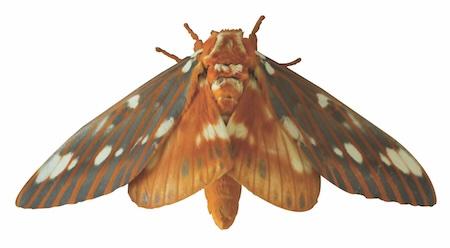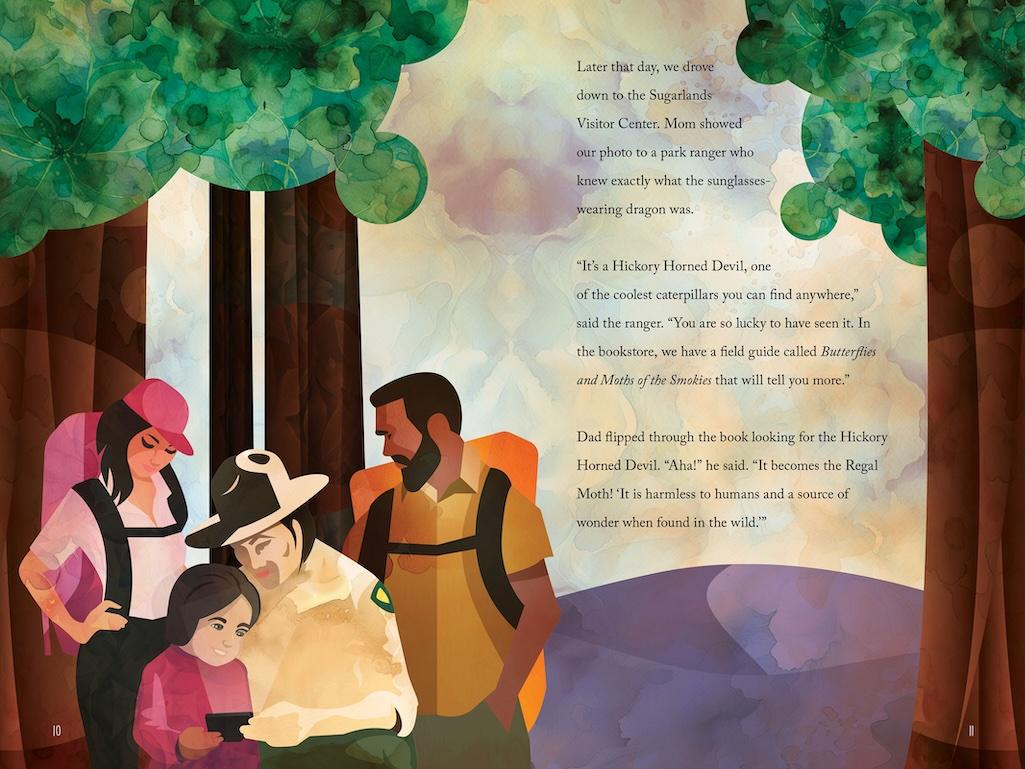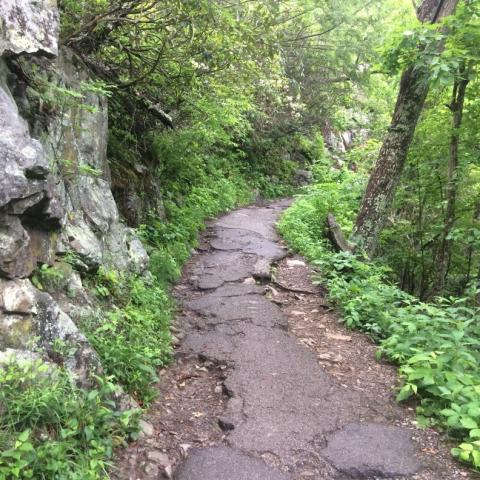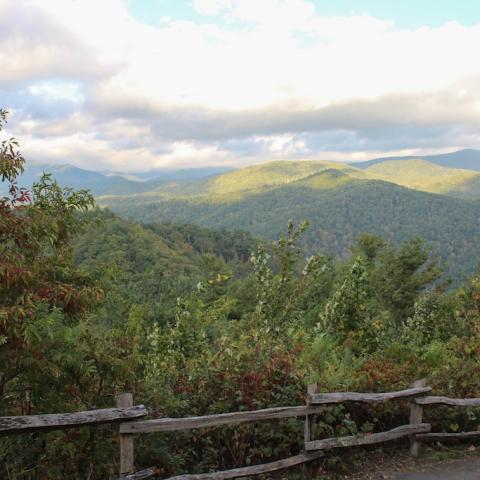Editor's note: National parks across the country are invaluable reservoirs of natural habitat that serve a vast array of species, ranging from the tiniest insects to the largest mammals. But for these ecosystems to thrive, the creatures that live within them need more than the scattered islands of natural landscapes national parks represent. Inspired by the Homegrown National Park movement, Camilla and the Caterpillars, a new children’s chapter book from Smokies Life, shows how families can fill their yards with native plants that provide native species a safe haven even in places far away from public lands.
The first time Camilla saw a caterpillar, she mistook the creature for a more fantastical apparition: a dragon wearing sunglasses. But when she learned the insect’s actual identity—a hickory horned devil, the five-inch-long caterpillar that transforms into the regal moth—Camilla wasn’t disappointed. She was entranced.
Thus begins the story of Camilla and the Caterpillars, a new children’s chapter book from Smokies Life written by Frances Figart and illustrated by Matt Brass. Figart, who also holds the position of creative services director at Smokies Life, said that she hopes the tale will give kids “that spark of hope that they can create the future they want for this planet” while helping families “see how important it is for them to support kids in realizing their dreams.”
After that first encounter ignites her interest in caterpillars when Camilla is just four years old, over the following years she makes it her mission to seek out new species every time her parents take her to a new national park. But when her family moves away from their city apartment into a suburban home with a yard, she can’t find a single caterpillar there.
“Compared to the city, it was very quiet,” she narrates as a 12-year-old looking back on her life. “In fact, come to think of it, we couldn’t even hear a bird singing or a bee buzzing.” That’s because the family’s half acre was devoid of native plants and overrun with invasive species.
Then Camilla learns from family friend Carlos—who is “getting a PhD in nature”—about a movement that encourages people to create wildlife-friendly habitat in their own backyards. Carlos, Camilla, and her parents get to work, and after several years of managing invasive plants and planting native ones, the property becomes home not only to Camilla’s beloved caterpillars but also to bees, bobcats, barred owls, and more.
Though the story is about a fictional child and her fictional family, it’s informed by Figart’s own journey toward understanding the important role native plants play in the ecosystem. Eleven years ago, Figart bought a home in Asheville whose small yard was filled with “a curious plant” that turned out to be invasive Japanese knotweed. When she started dating the man who later became her husband, he launched a two-year battle to eradicate the invader before the couple married and moved to his six-acre property in East Tennessee, which he’d planted with a diversity of native species. Meanwhile, he slowly taught her about the important role these plants play in supporting a healthy ecosystem—unlike exotic ornamentals, they offer food to a variety of living things, supporting robust populations of caterpillars, birds, and other wildlife.
“I am not a green thumb,” Figart said, “and I gravitate more toward animals than plants. But when I started to understand that non-native plants weren’t helping, and it was the native plants that would bring the animals to a particular landscape, I could get behind the concept of planting native.”
Figart’s second turning point came in 2023, when she interviewed ecologist and entomologist Doug Tallamy in connection with a talk he gave celebrating park partner Discover Life in America’s 25th anniversary. Since 2007, Tallamy’s work has focused on encouraging Americans to replace grassy lawns with native plants. There are an estimated 40 million acres of lawn in this country—converting half that amount to native habitat would support wildlife in an area larger than Great Smoky Mountains, Yosemite, Yellowstone, Badlands, and Denali national parks combined.

In this real-life photograph of a hickory horned devil taken by author Frances Figart, it’s clear how her book’s young protagonist might have mistaken the caterpillar for a “tiny dragon wearing sunglasses.”/Frances Figart.
“On our property [in Pennsylvania], I’ve been counting the number of moth species in the last five years that are now making a living at our house because we put the plants back, and I’m up to 1,199 species that have come back to our ten acres,” Tallamy told Figart. “That’s 44 percent of all the species found in the entire state of Pennsylvania. It’s because we put the plants back. What would happen if everybody put the plants back?”
Tallamy gave his talk on Earth Day in April 2023. Two weeks later, Figart emailed him to ask if they could chat about a book concept. That conversation took place on May 15, and within three weeks Figart had sent Tallamy a draft of Camilla and the Caterpillars.
Figart hopes that young readers will see bits of themselves in Camilla, who she describes as “an introverted child” who connects to the world through stories of adventure, with imaginary dragons and fairies as the main characters. Meeting the hickory horned devil shows her that nature can be “even more amazing than make-believe stories,” spurring a newfound passion for the outdoors that gives her “a niche and a way to feel comfortable in the world.”
The text of the book didn’t change much from that initial version, but Figart knew that quality illustrations would be vital to bringing readers into Camilla’s world of adventure and imagination. For that, she contacted Knoxville-based artist Matt Brass.

The regal moth is one of North America’s largest moths. In Camilla and the Caterpillars, Camilla’s efforts to create caterpillar habitat in her backyard pay off when a gigantic regal moth comes tapping on her window in the book’s final chapter/Liz Domingue.
Though Brass had never illustrated a children’s book before, Figart loved the colorful, imaginative style he exhibited in his other work, such as the commemorative, place-based sticker designs he produces for his company Smoky Outfitters. And for Brass, who previously spent 17 years with an ad agency specializing in sustainability and environment, departing as vice president of creative, Camilla’s message resonated loudly.
“I actually have a yard like that myself,” he said. “We have very little grass, and we have a lot of native plants, a lot of insects. So it’s very close to home for me.”
Brass’s first priority as he began work on Camilla was to develop the title character, creating a look that was both distinctive enough to communicate her unique personality and versatile enough to display the range of emotions Camilla experiences throughout the story, as well as her growth from a four-year-old in the book’s first pages to a sixth grader in its last ones. He described his approach to the scenes as “a visual version of how Charlie Brown handled audio”—that is, the adults are stylized characters that almost fade into the background, while the children, Camilla and Carlos’ son Diego, are more detailed. With support from Smokies Life’s Design Team Manager Karen Key, who designed the book, Brass used a digital tablet to create his illustrations, applying a collection of digital watercolor washes to saturate the scenes with the vibrant color that imbues the fantastical quality found in Camilla’s pages.
The result, he said, is something he’s proud of—both artistically and philosophically. It’s easy to get caught up in the world’s seemingly unsolvable big-picture problems, but lately, Brass has been embracing the idea of simply getting up in the morning and doing whatever right thing is within his control to do. Just one year after planting his lawn with native species, he can see the tangible results of this new philosophy whenever he looks out the window.

A colorful illustration by Matt Brass shows a young Camilla getting her first lesson on the important role caterpillars play in the landscape from a ranger in Great Smoky Mountains National Park. Image provided by Smokies Life.
“There’s a little bitty world in my backyard that didn’t exist, and that’s a powerful thing and a beautiful thing,” he said. “I haven’t changed the world, but I’ve created a little world of my own where these creatures are living.”
That’s a priceless gift, Figart agrees. About five years ago, she put up trail cameras to monitor her property’s nighttime visitors, and now she’s regularly treated to images of bear, deer, fox, coyote, opossum, skunk, raccoon, long-tailed weasel, flying squirrel, and bobcat.
“These precious members of the animal kingdom are here because we have returned the plants that belong here,” she said, “restoring the landscape as Camilla and her family do.”
Purchase a copy of Camilla and the Caterpillars at SmokiesLife.org. For information about how to establish your own Homegrown National Park, visit HomeGrownNationalPark.org.





 Support Essential Coverage of Essential Places
Support Essential Coverage of Essential Places






